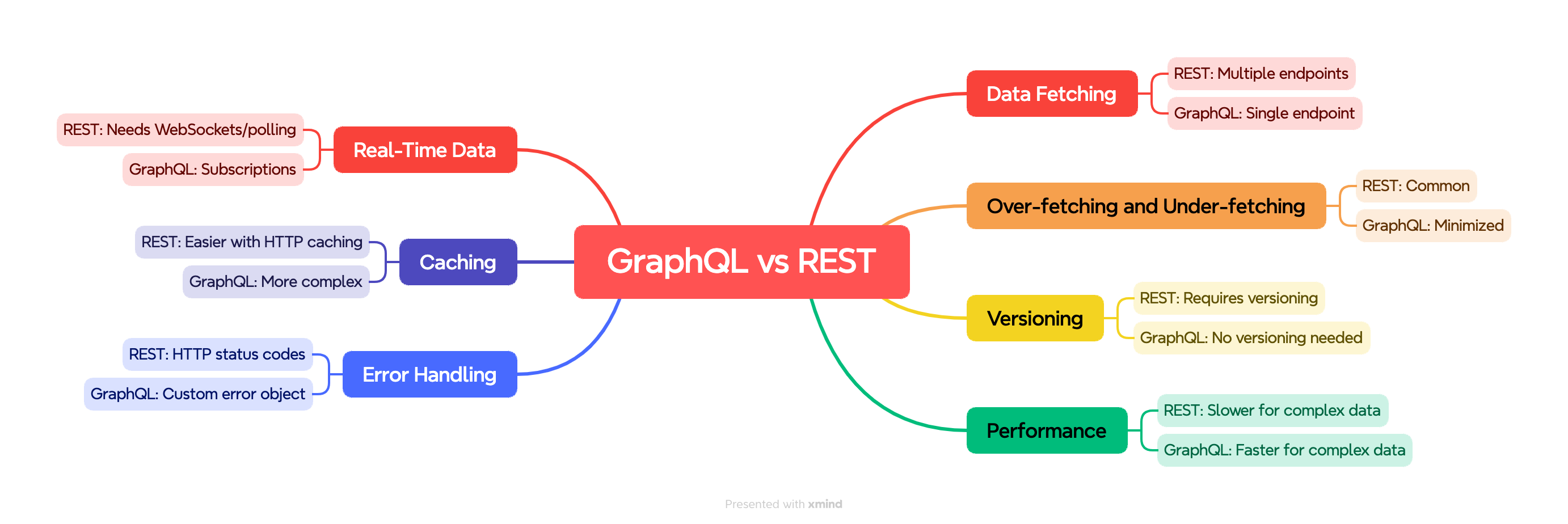Difference between GraphQL and REST
Difference between GraphQL and REST (Representational State Transfer)

1. Data Fetching
- REST: Uses multiple endpoints for different resources. Each resource (e.g., /users, /posts) has its own endpoint, and to get data from multiple resources, you may need to make multiple requests.
- GraphQL: Uses a single endpoint for all requests. You can fetch exactly what you need in a single query, even if the data comes from multiple resources.
Example:
- REST: You may need to call /users and /posts separately to get data about users and their posts.
- GraphQL: A single query can fetch both users and their posts simultaneously.
2. Over-fetching and Under-fetching
- REST: Often leads to over-fetching or under-fetching. Over-fetching occurs when more data than necessary is retrieved, while under-fetching happens when you don't get enough data in one request, requiring additional requests.
- GraphQL: Minimizes over-fetching and under-fetching because you specify exactly the data fields you need in your query.
Example:
- REST: If you need only a user’s name but the /users endpoint returns name, email, and age, you get unwanted data.
- GraphQL: You can request only the name field.
3. Flexibility and Versioning
- REST: Typically requires versioning (/v1/users, /v2/users) as APIs evolve, which can lead to multiple endpoints for different versions.
- GraphQL: Doesn’t require versioning because the schema can evolve. New fields can be added without affecting existing queries.
4. Performance
- REST: Multiple round trips to the server may be needed to gather all necessary data, which can lead to slower performance.
- GraphQL: Typically faster for complex data fetching, as it reduces the number of requests by aggregating all needed data in one request.
Note: However, GraphQL can be less performant for simple, one-resource fetches because the server needs to parse and resolve a more complex query structure.
5. Error Handling
- REST: Uses HTTP status codes (e.g., 404, 500) to handle errors.
- GraphQL: Always returns a 200 OK status for queries but includes error details in the response’s error object, making it more uniform but less integrated with HTTP status codes.
6. Caching
- REST: Has better caching at the HTTP level because each endpoint corresponds to a specific resource that can be cached using standard techniques.
- GraphQL: More challenging to cache, as all requests go through a single endpoint, making it harder to leverage traditional HTTP caching mechanisms.
7. Tooling and Ecosystem
- REST: Is widely adopted with many mature libraries, frameworks, and built-in browser tools.
- GraphQL: Has a growing ecosystem with modern tools (e.g., Apollo Client), but requires more setup and learning, especially for caching and error handling.
8. Real-Time Data
- REST: Not natively designed for real-time data. Requires polling or additional tools (e.g., WebSockets) for real-time capabilities.
- GraphQL: Offers built-in support for real-time data through subscriptions.
Concise Summary:
| Aspect | REST | GraphQL |
|---|---|---|
| Data Fetching | Multiple endpoints | Single endpoint |
| Over/Under Fetching | Common problem | Rare due to selective querying |
| Versioning | Requires versioning | No versioning needed |
| Performance | Slower for complex data | Faster for complex data |
| Error Handling | HTTP status codes | Custom error objects |
| Caching | Easier with HTTP caching | More challenging |
| Real-Time Data | Needs extra tools (e.g., WebSockets) | Supports subscriptions |
Test Questions
- How does GraphQL handle over-fetching and under-fetching differently from REST?
- Why might GraphQL be less suitable for simple data-fetching tasks compared to REST?
- How does error handling differ between REST and GraphQL?
- In what scenarios would REST’s versioning be a disadvantage compared to GraphQL?
- By understanding these points, you can decide which approach—GraphQL or REST—best suits different requirements in API design and data fetching scenarios.